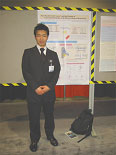|
Kawashima Lab, Tzu-Ying Lee
I am an international student whether in Tokyo or California. It was not difficult for me to accommodate myself to another country. Therefore I could enjoy the living and studying in the USA very quickly. When I checked in University of California, Irvine (UCI), I was surprised that the ratio of Asian students is over 50%. Most Asian students are Asian Americans. Although look like Asians, they behave as Americans completely. There are many activities, such as outdoor singing performance, dancing performance, speech, and stands for selling fashion stuff or foods etc. on UCI campus during lunch time every weekday. I found that American students are livelier, freer and dare to show themselves to the public. Japanese students, however, are steadier, more rigid and less unwilling to show themselves to the public. In lectures, American students usually ask questions, which may be simple or probably wrong. Japanese students seldom inquire but mostly professors ask students to answer questions instead. In fact, in my country, Taiwan, students behave like Japanese students. Due to the similar systems of education, most students have to pass the sequent, strict entrance examinations. Then they can enter senior high schools, colleges, and graduate schools. The examination system influences a lot the learning attitude and goal of younger students. Although Asian American students have the same appearances, they behave in a different way from Asian students due to different systems of education, culture, tradition and values. By the way, living in the USA, you need a car or you cannot go anywhere. In Japan, thanks to the convenient public transit, one can go almost anywhere without a car. Besides, people can stay outside safely until midnight in Japan, which is not the case in the USA because public security is bad. In summary, I benefited greatly not only in research but also in experiencing the USA from this trip. Finally, I acknowledge the grant from the Center for Urban Earthquake Engineering, which made this trip possible and beneficial.
| ■ COE海外特別研修 (University of California, San Diego) |
三木研究室 田辺 篤史
University of California, San Diego(UCSD)で2ヶ月半の研修として,授業,文献調査,presentation & discussionの3つを主に行ってきました.UCSDの授業は実用面に重きを置いたもので,日本の大学の理論重視とは異なっており,なかなか興味深いものがありました.文献調査では,膨大な文献が電子化されオフィスに居ながらにして必要な文献の検索と取得が可能であることに驚きました.あらゆる分野の文献が電子化され,インターネットを介して取得でき,さらに古い紙媒体の文献も電子化されているため,他分野の成果を容易に取り込むことが可能となっていました.この面では,日本の論文事情は10年近く遅れており,発展が必要と感じました.このように研究環境が日本とはかなり異なっており,現在アメリカの大学が世界をリードしている理由の一つであることが実感としてわかりました.
残念な点としまして,VISA取得に関する情報不足により出発が遅れ,滞在期間が予定の3ヶ月より短縮されたことがあります.また,出発時は準備で精神的に参ってしまい,初のアメリカ到着にも感動ができず残念です.
今回の海外研修では,自分なりにいろいろと体験してきましたが,自分が考える最大の成果は多くの研究者との交流です.UCSDの研究者だけでなく,アメリカ滞在の最後はロングビーチで行われたシンポジウムに参加し,韓国や日本からきた若手研究者とも交流を得ることができました.
以上のように今回の海外研修では得難い数多くの経験を得ることができました.このような機会を与えてくださったCOE関係者に感謝いたします。
山田研究室 吉敷祥一
| 平成15年度海外短期研修制度を利用して、平成16年3月24日〜27日 米国カリフォルニア州ロングビーチで行われた第7回 環太平洋鋼構造国際会議(Pacific Structural Steel Conference)に参加してきました。この国際会議は地震が多発する環太平洋の鋼構造研究者が一堂に会する会議であり、鋼構造に関する最新の研究が発表されました。私の発表機会はポスターセッションであり、たどたどしい英語ではありましたが、多くの研究者に研究内容を説明し、貴重なご意見をいただきました。なかでもニュージーランドのHERA(Heavy Engineering Research Association)のCharles Clifton氏、Raed Zaki氏とは、研究対象が近いこともあり、帰国後もe-mailで情報交換などを行っています |
 |
|
